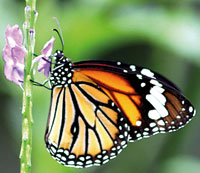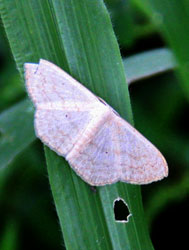Dr. Michael Van der Poorten keeps his garden well stocked with poisonous plants. A few leaves from the patch of Kalanchoe growing in the shade are enough to make up a fatal dose while the slender vine of Tragia spp, a stinging nettle, lies close to the path, ready to inflict intense itching on anyone foolish enough to step on it.
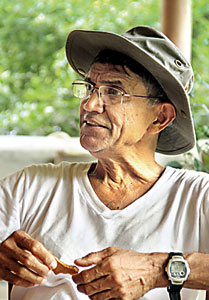 |
Butterfly Man: Michael Van der Poorten.
Pix by Indika Handuwala |
This lethal smörgåsbord is a delight however to at least one creature – butterflies. There are hundreds in this garden alone and though the sun is shaded by rain clouds, several flutter lazily around, held aloft by delicate, exquisitely patterned wings. But those vivid colours and idle flight are in fact a warning to predators – dining on the plants has allowed the insects to imbibe their toxins. “These butterflies are all poisonous, no birds will eat them. They’re a highly undesirable mouthful,” says Michael.
Michael's secluded 50 acre estate off Wariyapola is where the renowned Sri Lankan lepidopterist spends six months of the year (he is in Toronto for the other six). He has been dividing his time between the two countries (and their butterflies) for years. Having graduated from the University of Peradeniya in 1974 with an honours degree in agriculture, he then went on to earn an MSc in Crop Physiology and PhD in Plant Physiology from the University of Guelph.
He then made a dramatic shift to an entirely different field of study, mathematics and computer science - he says he made the choice with his finances in mind. He would spend 20 years in Canada working in IT, specializing in IBM Databases.
But whatever Michael was doing his love for the natural world remained undiminished. He loved not only butterflies, which he began actively studying in 1962, but birds as well. Close to a 100 species of the latter have been recorded at the estate. He has spent many a holiday travelling around studying the island's butterflies and becoming in the process one of the authorities in Sri Lankan lepidopterology. He is known as the man who in 2008 discovered and identified the first new species of butterfly for Sri Lanka in over 60 years - Catopsilia scylla or the Orange Migrant. He also discovered a skipper new to Sri Lanka, Cephrenes trichopepla.
"I'm a perennial student," he says ruefully. When here he is always in demand: a charismatic speaker, he engages audiences with off the cuff lectures and conducts and writes original research, sharing his expertise with organisations like the Forest Department and the Department of Wildlife as well. All this, while keeping an eye on his coconut trees. They grow tall and strong here, though this land represents only a small portion of a sprawling plantation once owned by his father.
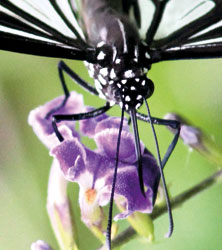 |
| Blue Tiger |
|
| Common Tiger |
His long verandah offers a gorgeous view of one of the three large ponds on the estate. In the dry months, the animals gather around them but now just after the rains they need not risk exposure.
A porcupine den is a dark hole in the small embankment and deep ant hills could house venomous snakes; there are mongooses and mouse deer as well, but we don’t see them. Aside from the patches with coconut, papaya and banana trees are planted, the land appears untended but an expert would recognize it as an invitation to a certain insect. “This looks like a bit of a mess right?” says Michael, explaining “But this is really not a mess, this is a carefully orchestrated garden for the purpose of attracting as many butterflies as possible.”
It has taken him decades, but his success is evident – there are an estimated 120 species in his garden alone, all drawn here by the facilities on offer. “We planted the plants and they come,” he says, showing us around. “This place has butterflies all the time because we have everything they need. It is not what you would call an eatery – where they might have to go someplace else to sleep.
Here we provide bedding, a nursery, food, and also the girls.” There could be no better guide to this slice of Eden than Michael himself. Dressed in a comfortable white t-shirt, shorts, walking shoes and a wide brimmed Tilly hat (he has five but the one on his head is his favourite), he knows the intimate detail of every butterfly’s life here – where it lays its eggs, which plants the larvae prefer, where the adults love to congregate. He takes long walks every day: “I sometimes spend two hours just trying to get a picture of the underside of a butterfly.”
Now, while we’re still looking wildly around, he has already spotted the plant on which the butterfly we were tracking has landed. He bends over it and with a quick movement, gently but firmly pinions its wings. Michael identifies it as a Glassy Tiger male, pointing out the two round “sex brands” on its wings. These exude heady pheromones that can be relied upon to seduce females. The lovely patterns of their wings are unique to each variety of butterfly – though clever ‘mimics’ might fool predators into believing them poisonous too – and even within a species, each individual is distinctive. “No two will look exactly the same,” says Michael, revealing that under a microscope subtle differences become visible. Now, still in his hands, the male butterfly is utterly motionless – playing dead. The moment it is freed, it flutters away with uncharacteristic haste, leaving Michael’s fingers lightly dusted with its poison.
Our extraordinary tour offers up many other highlights: we watch a tiny Grass Blue curl her abdomen and lay her miniscule eggs with startling precision in a bud of Dipteracanthus prostratus. We disturb the White Four-Ring where it feeds on grass.
The larva of these lovely little butterflies will nestle close to the roots to avoid becoming a meal for grazing cattle. At the Kalanchoe patch we meet the tiny but gorgeous Red Pierrot. White, red and black, it allows its dramatic colouring to warn predators off. It is the only butterfly in Sri Lanka that feeds in between leaves, says Michael. Gently peeling the top off a leaf, he reveals a bright yellow larva.
It has hollowed out the leaf, and though it shares its space with black beads of its own excrement, it remains entirely clean, working its way neatly from one end to the other. It is still growing – through its translucent skin I can clearly see the steady pulsing of blood in a vein.
|
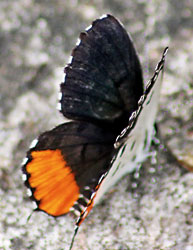 |
| Red Pierrot |
We see Psyches and Sailors and hear of how the larvae of Common Acacia Blues reward ‘bodyguard’ Crematogaster ants with beads of honey.
Further revelations about the complex relationship between the ants and butterflies are likely to play a starring role in some truly ground-breaking research papers that will be published later this year but for the general public, it is Michael’s long anticipated book that we are curious about. The comprehensive work will draw from a lifetime of study and should finally be out in late 2012.
He has set the bar high for himself – “philosophically I believe, if you’re going to write something, write something that is new.” Aiding him in his quest is Nancy, his wife of 30 years. Once the Chairperson of the Toronto Entomologists Association, she studies dragonflies but has long been Michael’s most reliable partner in his research.
Our tour finishes back on his verandah, where he serves us lime juice and slices of papaya from his garden. Here the conversation takes an unexpected turn when Michael promises to send me a link to the website of the Venerable Punnaji Maha Thera along with the research papers I requested.
Buddhist philosophy is his new passion he says, sharing his determination to delve deep into the human experience. He embraces this rigorous, very personal investigation as a process that sharpens his intellect. "We are here to better ourselves," he says, "if not to better ourselves, than why else are we alive?"
Butterfly talk
The Butterfly Fauna Of Sri Lanka by Dr. Michael Van der Poorten will be the 39th lecture in the monthly lecture series of the National Trust of Sri Lanka and will be held at the HNB auditorium, 22nd Floor, HNB Towers, 479 T.B. Jayah Mawatha, Colombo 10 at 6.30 p.m. on Thursday, April 26. The lecture is open to all. |



